News
» Go to news mainWomen in Agriculture: Shattering the glass ceiling
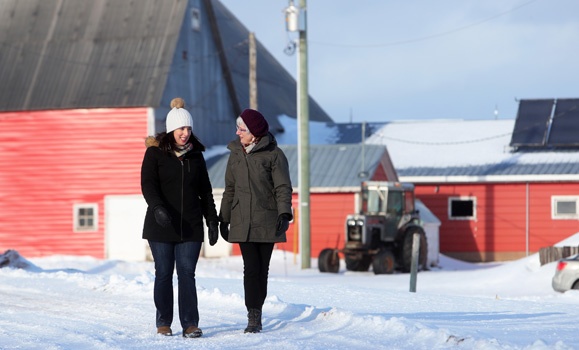
By Emma Geldart
In the past, women have often been underestimated for some of their abilities.
Like their ability to feed the world.
Let the evidence show, women in agriculture have shattered the glass ceiling. From running the farm solo to taking on non-traditional agribusiness leadership roles, the ladies are taking over the industry. With ever-increasing momentum, their phenomenal leadership skills and work ethic is changing the landscape of the agriculture industry from coast to coast and beyond.
The numbers don’t lie
According to the latest 2016 Census of Agriculture, from 2011 to 2016 the percentage of women running their agriculture business alone rose from 5.6 per cent to 7.2 per cent. In addition, the proportion of female farm operators saw an increase from 27.4 per cent in 2011 to 28.7 per cent in 2016. Statistics Canada notes this is a long-term trend that began in 1991, when women accounted for only 25.7 per cent of all farmers. Further still, a study at the University of Manitoba shows that more than 55 per cent of new farmers in Atlantic Canada are women.
While it may seem like a recently emerging trend, women are certainly not strangers to agriculture, especially at Dalhousie University Agricultural Campus. Although the numbers were significantly lower than they are today, women have participated in courses at the AC (then known as the Nova Scotia Agricultural College) since the early 1900s. Many of the first female graduates of NSAC were the only women in their classes and were among the first women in Canada to pursue studies in agriculture and related sciences. Some went on to work in new technical and professional careers associated with government services while others made contributions to rural, social and educational development and the development of family farms.
“I think it’s important to recognise that women have always played an incredibly important role in agriculture but that they have not been given the recognition they justly deserve,” says David Gray, Dean, Faculty of Agriculture. “What is both exciting and well overdue is that we are seeing women taking on more leadership roles in agriculture. We want our agricultural sector to be competitive internationally and by recognising the crucial role that women have and continue to play in agriculture and by actively encouraging women to take their rightful place as leaders, we are increasing our competitive edge substantially. The AC is proud to see that the number of women choosing to study agriculture related programs on our campus continues to grow. We embrace diversity and are a truly inclusive community. Diversity should be encouraged; diversity makes us stronger.”
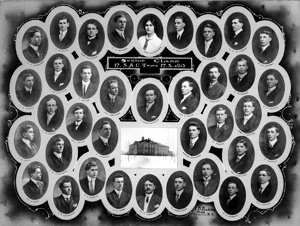 In 1913, Helen Woodroffe was listed as the first female graduate in the record of graduates from NSAC. Soon after her graduation, Helen became employed at NSAC as an assistant in bacteriology and was the college librarian. Helen, among many other early female graduates, certainly paved the way for women in agriculture and sciences and helped move the industry, and the role of women within, to where it is today.
In 1913, Helen Woodroffe was listed as the first female graduate in the record of graduates from NSAC. Soon after her graduation, Helen became employed at NSAC as an assistant in bacteriology and was the college librarian. Helen, among many other early female graduates, certainly paved the way for women in agriculture and sciences and helped move the industry, and the role of women within, to where it is today.
Currently, the ratio of female to male students studying at the AC is roughly 60/40. According to the official December 1, 2018 report that captures the breakdown of students enrolled in studies at Dalhousie University, there are 395 undergraduate female students while there are 247 undergraduate male students at the Agricultural Campus. The trend is reflected amongst graduate students as well, with 45 female graduate students and 27 male graduate students.
“The majority of students studying on our campus are now female,” says Dean Gray. “Considering the fact that agriculture had historically been a male-dominated discipline, this is something we are very proud of. We hope that we will help encourage and support many of our female students to go on to take leadership roles as we collectively approach the global challenges of food security, water shortages and climate change. We will need ALL of our bright young minds working together in agriculture if we are to find solutions.”
The barriers can be tough to break
The significant contributions of women in agriculture are evident all around us, but it certainly wasn’t easy for many of them to get where they are today. While some women were born on farms and into a farming lifestyle, others have had to wrestle their way to the top. Even still, females born into agriculture families had to fight the stigma that often preceded them.
Today, a number of women working directly on farms are regarded as the primary decision makers. Their roles extend far beyond the roles that gender stereotypes had commonly pegged as “women’s work.” Women work hands-on in all aspects of farming. They both operate and maintain machinery. They do the heavy lifting and oversee the livestock. They balance the finances and ensure the farm remains sustainable for the generations to come. They ensure on-farm technology is always in working order, and so much more. Their ability to run the farm, making decisions, solving problem, and often leading a team of employees, is certainly no small task. What’s more, these incredibly hard working women are often raising families as well. Most work alongside their partners or families.
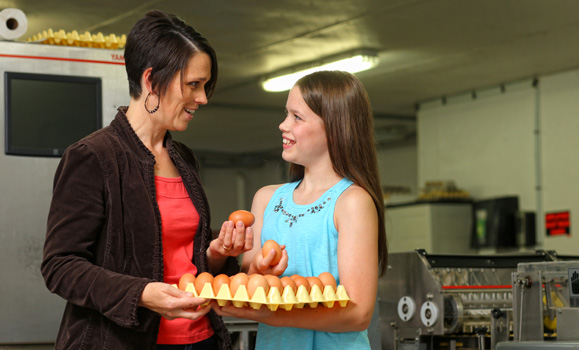 More women are also stepping up to take on leadership positions on commodity boards, associations and in senior management roles in non-traditional roles of agribusiness. With these increasing numbers in female role models, women working their way up look to these fearless leaders for advice and mentorship.
More women are also stepping up to take on leadership positions on commodity boards, associations and in senior management roles in non-traditional roles of agribusiness. With these increasing numbers in female role models, women working their way up look to these fearless leaders for advice and mentorship.
The Chicken Farmers of Ontario (CFO) has noted this trend of women in agriculture and are committed to ensuring women feel confident to overcome any challenges they may be faced with. To help women get more involved, CFO has launched an initiative to help women take on roles within commodity boards and associations.
The CFO Women in Leadership program sponsors the Advancing Women in Agriculture Conference, a Canadian initiative committed to the movement of advancing women in agriculture. Also through the program, the CFO board of directors encourages its farmer-members to plan and participate in community activities. Funding is made available to eligible farmer-members to execute these community programs, to help farm women become more involved.
Despite outdated stereotypes, females across the country are blowing these barriers out of the water and making their dreams a reality. Women are thriving in agriculture, both on and off the farm.
You’ll find them everywhere
For many family farms across the country, the strong and fearless women who run them are often the backbone of the family farm business. In the past, these women were typically known for preparing meals for the men, caring for the children, and ensuring the farm remains financially viable. While all important roles, today many women are recognized for their work directly on the farm. These women oversee daily operations and make decisions, roles that were typically associated with men. Other women work in non-traditional roles off-farm, making business decisions and voicing their concerns on commodity boards that they sit on. Even still, some do it all.
Jeannie van Dyk (Class of ’78) owns and operates a dairy farm with 280 Holsteins (120 milking) in Noel Shore, NS. Alongside her are her husband and two sons. In addition to their herd, Jeannie and her family crop approximately 600 acres with alfalfa, corn and pasture. Jeannie’s role on farm is certainly significant.
“Over the years I have worked in all aspects of farming including cropping, livestock care and running the business,” Jeannie explains humbly. “With my two son’s home now, I do very little of the field work preferring to work with the livestock. I do the night milking and every other weekend. I cover maternity cows and calf care and assist with the responsibilities of herd management and milk quality. I also oversee the business and do the books.”
Not only does she hold an important role on her family farm, Jeannie holds strong leadership positions on a number of industry boards. She is director and vice-chair on the board of Agropur Dairy Cooperative, a large dairy processing cooperative owned solely by 3,400 dairy producers across five provinces. She also represents Agropur on Co-operatives and Mutuals of Canada board and attends other dairy industry meetings on the Cooperative’s behalf.
With her direct involvement on the farm, Jeannie has noticed that the image surrounding women in agriculture has improved tremendously over the past number of years.
“For me, the hardest part of being a woman in agriculture has probably been the failure of some people to recognize us as farmers, owners and business people rather than as someone who simply helps out on the farm,” Jeannie explains. “Fortunately now, it is much more common for women to be recognized as a business person on farms or in agribusiness.”
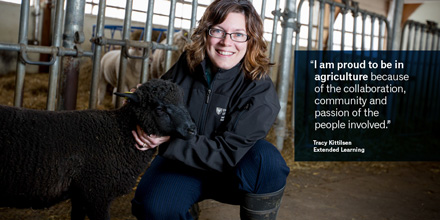 Echoing Jeannie’s sentiments, Tracy Kittilsen (Class of ’96) also feels as though perspectives of women in agriculture are changing for the better. As manager of Extended Learning at Dal AC, Tracy leads a team whose role it is to encourage innovation in the delivery of high-quality, flexible work based learning solutions for adult learners in agriculture and aquaculture. Working alongside and assisting powerful and inspiring women in agriculture, Tracy has noticed an increase in women in leadership positions within the agriculture industry.
Echoing Jeannie’s sentiments, Tracy Kittilsen (Class of ’96) also feels as though perspectives of women in agriculture are changing for the better. As manager of Extended Learning at Dal AC, Tracy leads a team whose role it is to encourage innovation in the delivery of high-quality, flexible work based learning solutions for adult learners in agriculture and aquaculture. Working alongside and assisting powerful and inspiring women in agriculture, Tracy has noticed an increase in women in leadership positions within the agriculture industry.
“I think traditionally agriculture was seen as a male dominated industry, but in reality that is not the side of agriculture I saw much of,” Tracy explains. “I grew up on a small mixed farm where everyone pulled their own weight and the motto was, ‘if you want something done you better do it yourself!’ Today as I go about the region and run into classmates from the AC and scan the crowds at meetings there are lots of women there – and in leadership roles. I think this is a sign of the times, where women are valued as equals.”
Tracy has also noticed this trend among youth in agriculture. For 10 years, Tracy was the general leader of her local 4-H club. When her kids were young, she took a break from the role and has now returned to the program as a project leader. She’s noticed the increase in female participants in the club in the return from her hiatus.
“On my return to the program I have noticed that there seems to be a lot more girls than boys involved,” Tracy says. “They’re involved in everything from leadership roles and projects such as beef and welding- projects that have, in the past, perhaps been more associated with boys..”
Like Tracy, Amanda Greaves (Class of ’10) has not had to overcome any barriers as a woman in a non-traditional role in agriculture. Amanda doesn’t own her own farm, but that doesn’t diminish her impact on the agriculture industry in Nova Scotia. Amanda currently works for LBJ Farm Equipment providing technical support for milking equipment on dairy farms. Growing up with horses and then studying poultry during her time at Dal AC, Amanda had her work cut out for her when accepted her first job with Shur-Gain.
“I was hired to do my first job working for Shur-Gain in dairy when I knew NOTHING about cows,” Amanda admits. “These farmers were trusting me as their nutrition consultant, to feed their animals. I wouldn’t have trusted myself! Farmers were so accepting of the fact that I was learning.”
Despite her role, Amanda has never felt any true barriers as a female working in a non-traditional agriculture position- a testament to the shifting perspectives in current society.
“Female or male, it doesn’t mean a thing to me,” Amanda states. “I don’t even look at gender roles- it’s the way I was raised. We need people to nurture the land, provide food and increase sustainability. We need willing capable human beings in general.”
While there are a fair share of women involved in the physical on-farm labour, women in agriculture extend far beyond everyday life on the farm. From non-traditional roles, to administrative support, to women in research, ladies are involved in many aspects of the agricultural supply chain. And while the perceptions certainly changing, many women in the industry are working hard to continue to improve these views.
Paving the way
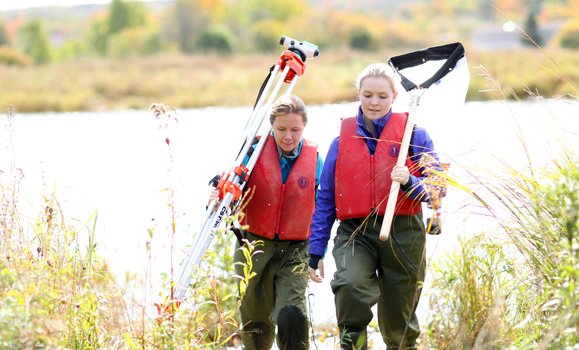 The perceptions of women in agriculture have improved significantly over the past number of years. While there is still certainly room for improvement, the same can’t always be said for women in agriculture in developing countries. Women in many developing countries often don’t hold the same rank as men and it is often rare to find a women in a position of leadership. Despite the many challenges, one Agricultural Campus alumnus is working hard to change that.
The perceptions of women in agriculture have improved significantly over the past number of years. While there is still certainly room for improvement, the same can’t always be said for women in agriculture in developing countries. Women in many developing countries often don’t hold the same rank as men and it is often rare to find a women in a position of leadership. Despite the many challenges, one Agricultural Campus alumnus is working hard to change that.
Lana Bos (Class of ’02 and ‘14), who is currently completing her MSc, works in in Extended Learning, at the Agricultural Campus, as an Education and Training Developer. She currently leads the development of national occupational standards and competency based curriculum for jobs in agriculture. She works in developing countries, currently Ethiopia and Uganda, facilitating workshops and training with partner colleges.
“As part of the development of occupational standards and curriculum we always include a gender focus in everything we do, from the participants in a training, down to using gender focalized examples in the teaching material,” Lana explains. “We must ensure that there are equal opportunities for male and female students and graduates working in agriculture and we seek to do this by integrating women into the curriculum. We try to empower female instructors and students at the college and also as leaders in the industry. We encourage women to become entrepreneurs and start their own businesses as well as take on more predominantly ‘male’ roles, such as production of livestock.”
In these countries, women are often very dependent on men. Women typically don’t have the ability to purchase land or have access to banks or loans and resources, including money. Traditionally, they stay at home, manage the household, collect water and firewood, look after the children, and grow food, among other duties. It is very realistic for women to be able to start their own source of income and be more independent and empowered within agriculture.
“Economic development and food sustainability is only possible if more women get more involved in leadership roles in agriculture,” Lana says. “Through our work, we are encouraging women to take on leadership roles in agriculture and we make sure the occupational standards and curriculum speak to equal opportunity.”
While Lana and her team work to bring women in agriculture to the forefront in these countries, Lana explains she has met her own challenges when visiting these countries to help educate.
“Women in these countries do not hold the same status as men,” she explains. “This has been challenging as often I am leading discussions and facilitating work with rooms full of men, that don’t necessarily see you as equal. This is often overcome when they realize we do know what we are doing and can help them achieve their overall goals.”
While Lana and her team are working to empower women in agriculture in developing countries, a number of initiatives are on the rise across Canada to engage and empower women in agriculture.
Within Atlantic Canada, the Atlantic Farm Women’s conference is hosted every 18 months to encourage collaboration and engagement among women in agriculture to help progress the industry. A relatively new initiative, the conference is entering its seventh year in 2019 and has been gaining momentum across Atlantic Canada ever since its inception in 2012.
The idea for the Atlantic Farm Women Conference stemmed from a conversation between Rayanne Frizzell (Class of ’03) and Amy Bysterveldt (Class of ‘03). The women got to chatting about a dairy conference that Rayanne didn’t attend with her husband. Rayanne admits she didn’t attend the conference because she’s not as connected to the family dairy farm and none of the topics interested her. After some brainstorming and a bit of research, they found that farm women’s conferences exist in Western Canada and the United States, but not necessarily in Eastern Canada. Their idea was born and Rayanne and Amy currently co-chair the initiative.
The conference typically hosts inspiring speakers, giveaways, farm tours, serious discussion and fun activities for women in agriculture. The conference isn’t limited to women who are involved directly with a farm- it’s open to all women interested or involved in the industry in a variety of ways.
Also encouraging collaboration among women in agriculture is the Ag Women’s Network (AWN), an online platform for women in agriculture that encourages women to share their experiences and learn from one another. As a volunteer-led network, AWN members are encouraged to engage in social media conversations, online discussions, and attend virtual events. The goal of AWN is to help women in agriculture around the globe to be better equipped and understand how to serve as more inclusive leaders.
It’s initiatives similar to these taking place across the country that allow women in agriculture to join together to share their knowledge and experience. In an industry that has been often viewed as male dominated, it’s reassuring for these women to know that they are definitely not alone in their struggles and triumphs.
The power of women
Women in agriculture have had to overcome some challenges. Their outstanding accomplishments in agriculture continue to grow and receive the recognition they deserve. Crashing through the glass ceiling that was said to be holding them back, women are dominating in the agricultural industry now more than ever. From coast to coast and overseas, women play an important role of putting food on the table for consumers all over the world. From their roles on the farm, in agribusiness, in non-traditional positions, research, and everything in between, the women are plowing through. Support and empowerment from their peers and mentors ensures these incredible, hard working women have the support system they need to thrive.
And thrive they are.
While their roles may have been underestimated in the past, it’s clear that the power of women in agriculture should not be misjudged.
Recent News
- 2025 Public Impact Award.
- From Markets to Meals: Dalhousie Researcher Leads Global Food Systems Study
- Applications for the Fall 2025 Collide Validate
- Convocation 2025
- Agriculture students turn wool into warmth
- Connection, Passion and Purpose
- Tractor Safety Course instructor
- Always more than one path
